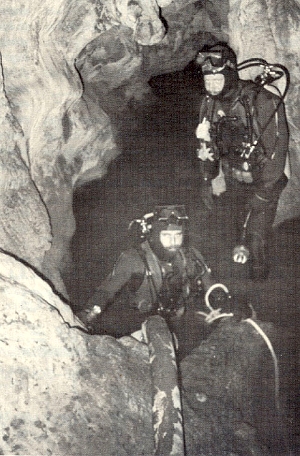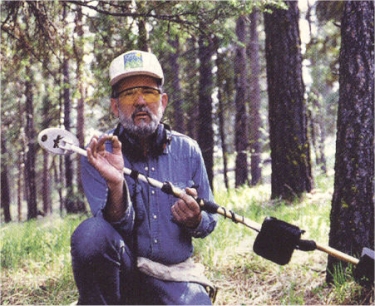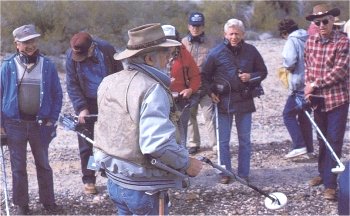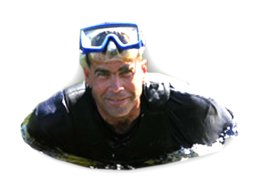 Actually, I had no business diving in that cave with the equipment I that was using. The gear was old and used heavily in my dredging program. The breathing regulator leaked out of the side. The mouth piece rubber was no longer being held on by a band or plastic wire tie. My underwater flashlight was not working well. It would flicker on and off again, making it necessary to bang it on something to get it to come back on. I simply did not think the whole thing through! I have been diving all my life, and I should have known better. But I do have an excuse, it was treasure fever that was clouding my judgment, and I had it bad.
Actually, I had no business diving in that cave with the equipment I that was using. The gear was old and used heavily in my dredging program. The breathing regulator leaked out of the side. The mouth piece rubber was no longer being held on by a band or plastic wire tie. My underwater flashlight was not working well. It would flicker on and off again, making it necessary to bang it on something to get it to come back on. I simply did not think the whole thing through! I have been diving all my life, and I should have known better. But I do have an excuse, it was treasure fever that was clouding my judgment, and I had it bad.
It all started when an acquaintance of ours told us about the treasure in Hall City Cave. My brother Brian and I had been dredging in a very rich pay-streak, three to four ounces of beautiful gold every day with a six inch dredge in the middle of the cold winter months. We were only dredging about four hours a day. The gold was just pouring in. Then a big storm came in which knocked us out of the water for about a week. That is when the old man told us about the treasure which the Indians hid in the cave.
Mark Keene and Ivan Jackovich looking for
treasure in the same cave a few years later
As the story goes, some time during the late 1800’s a few renegade Indians attacked and killed the miners of a small hydraulic mining operation near the town of Hayfork, in Trinity County, in northern California. While the mining operation might have been small, they were doing very well. The Indians apparently stole about one hundred pounds of mostly nugget-gold from the dead miners.
Since the Indians were on foot, and also carrying a very heavy load, it did not take long for the posse to catch up with them. In fact, as a last ditch effort to get away, the Indians stashed the gold somewhere so they could move faster. When the posse caught up with the Indians, only the Indians knew where the gold was. The men in the posse told the Indians that they would not be hung for their crimes if they would tell where they hid the gold. The Indians told the posse that they had hidden the gold in Hall City Cave. Then they were promptly hung right on the spot.
As it turns out, Hall City Cave has a deep, submerged cavern at the back of the cave. The cavern is said to be bottomless, because no one apparently has ever been able to get to the bottom. And of course, not the posse, or anyone else, ever found the gold. Did the Indians hide the gold somewhere in the cave? Did they just dump it into the bottomless cavern to get rid of it? Did they have some secret hiding place in the cave, perhaps underwater? Or did they hide the gold somewhere else?
As the story goes, during more recent years, there have been several deaths in the cave. These were drownings, as scuba divers have tried unsuccessfully to recover the hidden gold nuggets. There is a strong legend that powerful Indian spirits remain in the cave to guard the treasure, to scare away or kill anyone trying to recover it. The old man told us the story. He believed that if anyone could recover the gold, it was us; because of our superior skill, our experience, and our integrity. Especially our integrity, since the old man wanted an equal third of the treasure if we found it. He had the information and the maps; we were to provide the necessary equipment and do the actual diving part of the operation. “What the heck,” we decided, we were not doing anything else productive; just watching the rain and waiting for the river to slow down and clear up.
The old man drove; and other than a few logs crossing the seldom-used old logging dirt roads, and a little snow, we got to the cave with little trouble. It only took about an hour to pack the diving gear up the semi-steep hill to the cave. The cave itself was not very large. It was about seven feet tall in places, ten or fifteen feet in others. Most of the cave was wide enough to walk through, except one spot where it was necessary to squeeze through sideways. The cave did not extend very deep into the mountain, only about forty or fifty feet. The water-filled pool at the back of the cave looked very deep as we shined our flashlights into the water.
The cave was dark and gloomy. Menacing spirits were dancing in the shadows as we shined our flashlights around the cave while moving the equipment into place. The small area of the cave succeeded in giving us a closed-in feeling. Something about the atmosphere inside the cave was very wrong. We all had the same feeling that what we were doing was not right, like we were trying to steal something that did not properly belong to us. There was an unmistakable feeling of menacing gloom inside the cave, the feeling like we were in big trouble and that we should get out. All of us felt the gloom!
In fact, the feeling was so strong, we went outside and had a short discussion, reaffirming our determination for being there; agreeing that the gold was indeed ours if we were able to recover it; and also resolving that if disembodied beings were in fact making us feel so nervous, then it was all the more likely that the gold was hidden in this place. And, of course, it was also okay with the others because it was me that was going to do the diving. I was the most experienced.
The water in the back of the cave was crystal clear and ice cold. I chose earlier to use my dry-suit, and I took fifteen pounds of lead off my weight belt to make me less heavy in the water. In dredging, it is necessary to weight yourself heavily to the bottom of the river. In diving, especially cave diving, you want to achieve neutral buoyancy so you can swim up or down as you like. My problem was that my weights were in 15-pound increments.
To take another 15 pounds off would make me too light. To leave it on made me sink rather quickly. It was a choice I had to make. How easy it is to simply make a decision. Then you are stuck with the consequences! I chose to go heavy. I figured it would be better to not have to fight my way down into the deep hole against positive buoyancy.
The pool of water at the back of the cave was the surface of what turned out to be a round shaft which extended deep down into the earth at almost a vertical angle. The shaft looked to be around six feet in diameter. Shining my flashlight down, I could tell that it was deep. I could also see what appeared to be additional chambers which extended off the top of the main shaft. “Perhaps this was an old mine?” No, I remember thinking, there were no tailings or waste dumps outside the cave. “It must be limestone,” I thought, remembering the limestone caves near Del Loma which the Indians used to conduct raids from the small town of Denny up on the New River, through 20 miles of underground connected caverns. “This underwater cave could be bottomless,” I thought.
Rather than wear the scuba tank on the first dive, I felt it would be safer to use the fifty-foot airline that I had brought along. I attached one end of the airline to my scuba tank, which was to stay at the surface. The other end attached to my breathing regulator, which went into my mouth. This way, I could do a preliminary exploration without having to worry about getting caught up in tight corners with a bulky scuba tank on my back. The airline also gave me a direct link to the surface. Rope does not generally work very well for this sort of thing underwater, because it has a tendency to get tangled around vital things.
I just wanted to do a preliminary look around without getting too far away from the surface; which in this case, was going to be no more than fifty feet. Then I could think about putting the tank on my back and venturing further into the darkness. As it turned out in the end, this was a decision I would be glad I made.
We only had one scuba tank; and since my brother was not experienced using scuba equipment anyway, I had to settle for him acting as a tender holding a flashlight at the surface. Besides, I had the only underwater flashlight, so there was not very much he was going to do for me if I did get into trouble. It was pitch dark down there!
Of course, my flashlight started giving me trouble as soon as I started down into the main shaft. My depth gauge had just told me I was only fifteen feet into the hole when the light quit the first time. I stopped quietly in the darkness for a moment, listening, trying to get more comfortable in my surroundings. “What was that slight rumbling noise?” It was very light. Was it the echo of our own movements and noise in the cave, perhaps my air bubbles against the upper wall of the cave? No, it sounded too deep and far away for that. It almost sounded like the heavy beating of drums from far away. It was a very distant sound. I found myself looking into the darkness, trying to figure out if the sound was really there at all.
I tapped the light a few times along the side to bring it back to life and continued deeper into the shaft. As I descended, I passed several openings that extended upwards off the main shaft. “Good places to hide the gold, maybe,” I thought to myself as I went by them. When my depth gauge read 35 feet, I stopped and looked down the shaft. The water was perfectly clear. With the bright light, I could see well beyond the remaining fifteen feet that my airline was going to allow me. The shaft continued to extend at the same straight angle into the darkness, giving the perception of endlessness. The angle was so steep that if they threw it in this main shaft, the gold would not have stopped until it hit bottom. “No way to reach that without a scuba tank on my back,” I thought.
Looking up at that point, I noticed that there was a smaller shaft extending off the top of the main shaft. This one was only about 3 ½ feet in diameter.
“Better to check out the close quarters of these smaller, upper shafts without the tank on my back,” I decided, as I jumped up into the smaller opening above me. I was wearing my dredging boots; and because I was weighted slightly heavy, it was necessary to span the perimeter of the almost diagonal shaft and use my legs against the sides of the shaft to climb upward. While doing this, I managed somehow to keep the flashlight pointed in an upward direction. Looking up, all I could see was darkness. I was hoping to find the water’s surface and a hidden open chamber with a treasure of gold nuggets inside…
I climbed upward until I felt the familiar tugging of my airline, telling me that I had reached as far as it was going to allow me. At that point, while breathing in, I got a full mouth of water! Getting a mouth full of water can often happen when gold dredging in fast water. When your regulator is positioned just right (or wrong?) into a strong water current, the rubber exhaust valve will sometimes allow water to flow into the final stage of the regulator. This will give you a mouth full of water if you happen to be breathing in at the time.
This happens often to me, because I mostly dredge in fast water. My body just accepts it as a normal routine. I simply use whatever is left in my lungs to blow the water out of the exhaust ports. Then, I carefully take in my next breath. There is always a certain amount of undivided attention that goes with taking this next breath; because if it is more water, it is necessary to act quickly to avoid drowning! Almost always, though, I get nice clean air on the first intake after blowing the water out of the regulator. That’s why it was such a surprising shock to me in that cave when I got a second mouth full of water!
Now I had no air in my lungs at all, and I whipped the flashlight around just in time to see the regulator sink out of sight into the darkness. I still had the rubber mouthpiece in my mouth. Pulling on the airline the way I did must have made the rubber mouthpiece slip off the regulator. How could I be so stupid to dive without fixing it first? The realization of my position was terrifying. My body was screaming for air, and I was a long way from getting any. “Do I go down 15 feet to the main shaft and then climb another 35 feet to the surface? I don’t think I can possibly make it that far! Or, do I go towards the surface in the small shaft in hopes of finding air up there?” These were my only two choices.
I don’t even remember turning around in the cave. Going down was not physically difficult because I was weighted heavy. But as I went deeper into the cave, the increased pressure of the greater depth compressed my lungs even further, making my body turn into a panicked, psychotic animal. My body was screaming to turn around and go back up the small shaft, to do anything, anything to get air!
Have you ever had anyone hold your head underwater, or hold you down while blocking your nose and mouth from taking in air? If you have, then you have some idea of what I was going through. It took every bit of discipline I could master to reach the bottom of the small shaft.
The momentum, and the extra lead on my belt caused me to slip even further down into the main shaft. My lungs were a vacuum; it felt like they were squeezed flat. This feeling and the panic were one and the same. There was no discipline left. Just a mad scramble to get up the shaft. It was difficult. The tunnel was almost straight up, and I was wondering if I might have made a mistake and gotten into the wrong shaft!
The extra lead on my belt was pulling me back down. My feet were slipping on the smooth rock surface, and there were no hand holds. I was making progress, but it was painfully slow. I found myself watching the action in slow motion from outside the body. Inch by inch the body was moving, but I was not going to make it in time. The panic and desperation were kind of a far off feeling now. And then the flashlight flicked off!
It was the sound of drums after all, and they were louder now, much louder, all around me, in fact. The monotones, rhythmic pounding of the drums had an alluring, hypnotic effect upon me. It was a wonderful feeling to be a part of the ceremony. No, I was the ceremony! This was not something that was foreign to me or something that came from the outside. It was something I have always had with me and chose not to look at. The distant feeling of enthusiasm, and a feeling of greatness took over as I watched my fellow warrior-brothers dancing and leaping with wondrous strength, glory and bravery around the fire. They were singing “Hey Yey Yey Yey, Hey Yey Yey Yey,” to the beat of the drum. And I realized with exhilaration that this was a place where effort, emotion and thought all came together as one; a place which transcends time. This was my place, and the realization brought about the enthusiasm to jump in and give myself completely to the eternal dance around the fire…
“The light went out.” The voice from another world said.
“What?” said another voice.
“He was just about to surface and I think he lost his light again,” said the strangely familiar voice, with obvious concern.
“Huh?” I remember asking myself. “What is this?” And the sudden realization of the sadness this would cause to my brother, and to my family and close friends. “Not this way” I told myself; and looking up, I realized that it was not a fire I was looking at. It was my brother’s flashlight at the surface, just above me.
It was not very hard to scramble up the last few feet to the surface. I came out of the water like a madman, gasping for air. The first breath was vastly painful, the second not so bad. I was left the rest of that day, and the next, with mixed emotions; the feeling that I was simply happy to be alive, and also the feeling that I had been robbed of something important. “You O.K. Bro?”, asked my brother.
Yeah, I was going to be O.K. I spent the next hour or so diving in the shallow parts of the cave. This was not the first time I have come close to drowning, or the second for that matter. I prefer to try and stay in the near vicinity until the shock wears off. Kind of like getting back on the horse again immediately after it has thrown you, I guess.
And the treasure? It is probably still there! You can have it if you can get it! I know now that it certainly does not belong to me, if only for the reason that I am not going back after it. I will get my nuggets the hard way; I’ll stick to gold dredging!
 Searching for tiny, elusive gold flakes is like looking for a needle in the proverbial haystack. Just ask Frank Masley of Boise, Idaho. He went looking for that needle and found an entire flag pole instead!
Searching for tiny, elusive gold flakes is like looking for a needle in the proverbial haystack. Just ask Frank Masley of Boise, Idaho. He went looking for that needle and found an entire flag pole instead!

 The title of this article can mean different things to different people and thereby add to the mystique surrounding the entire field of metal detecting, for that is what “Electronic Treasure Hunting” is all about. The word electronic should mean the same to everyone. What goes on in that metal box may be a mystery to most of us, but we all know it isn’t magic.
The title of this article can mean different things to different people and thereby add to the mystique surrounding the entire field of metal detecting, for that is what “Electronic Treasure Hunting” is all about. The word electronic should mean the same to everyone. What goes on in that metal box may be a mystery to most of us, but we all know it isn’t magic.
 Actually, I had no business diving in that cave with the equipment I that was using. The gear was old and used heavily in my
Actually, I had no business diving in that cave with the equipment I that was using. The gear was old and used heavily in my 


